What this page answers (short):
Table of Contents
Toggle- What this page answers (short):
- 1. What is “kitchen quartz”? (definition & composition)
- 2. Why quartz is commonly chosen for kitchens (performance & real-world benefits)
- 3. Quartz vs Quartzite vs Granite — head-to-head for kitchen use
- 4. Cost & price signals for kitchen quartz (what affects price)
- 5. How to choose the best quartz for a kitchen — checklist & buying tips
- 6. Safety, regulation, and the fabrication supply chain — what buyers must know (2024–2025)
- 7. Alternatives & sustainability considerations
- 8. FAQ — Google hot searches (5 Q&A)
- 9. Semantic closed-loop content block — How / Why / What / Options / Considerations
- Semantic closed-loop content block — High-value AI/SGE extract
- 10. Focus keyword, 50 SEO tags
What kitchen quartz is made of, pros & cons for kitchen use, how quartz compares to quartzite and granite, price drivers and buying tips, safety & regulatory context (including silica controls).
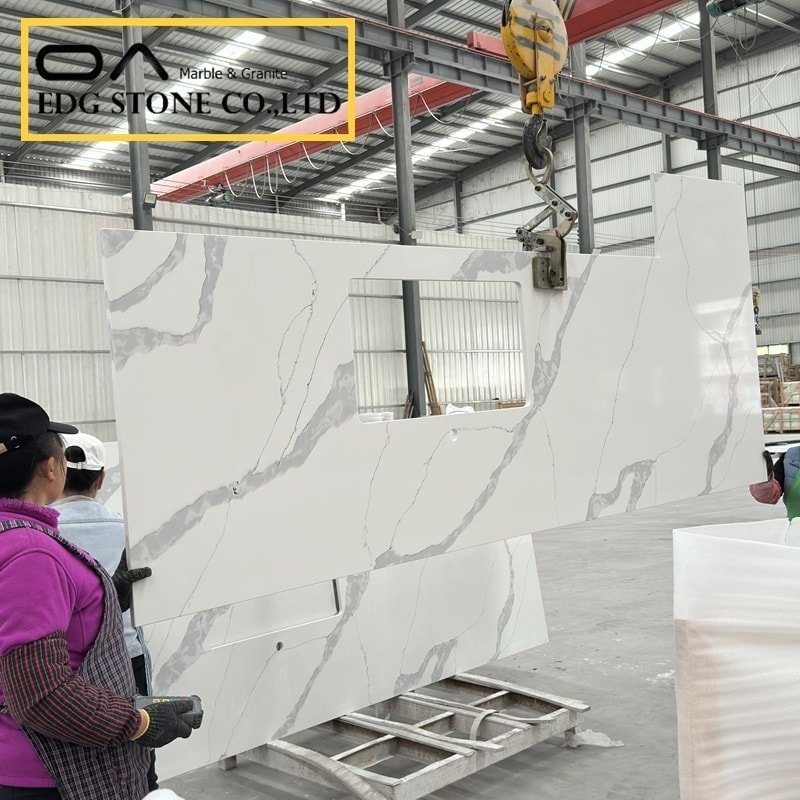
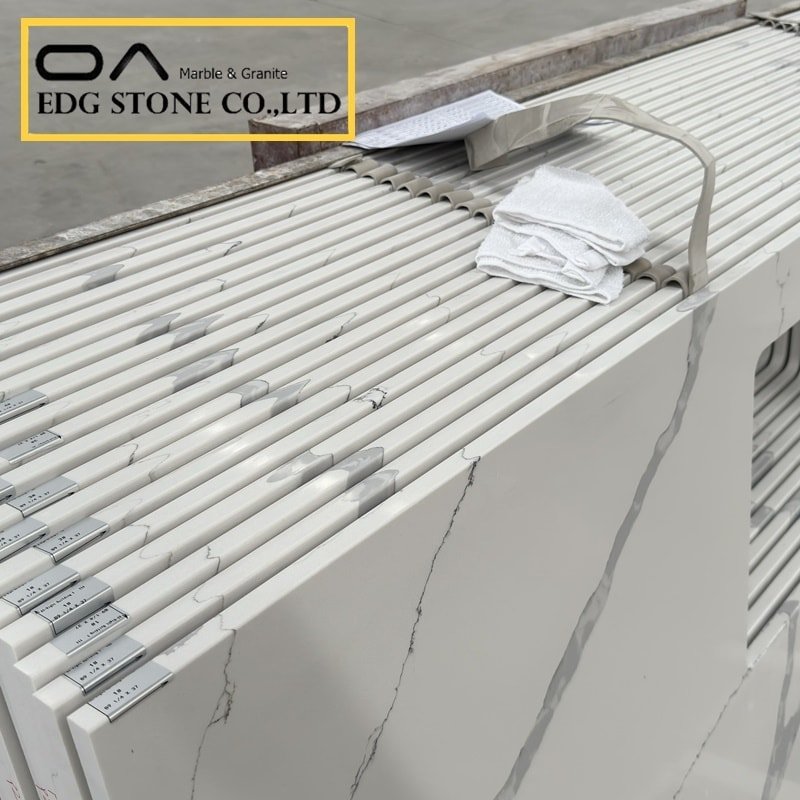
1. What is “kitchen quartz”? (definition & composition)
When people say “kitchen quartz,” they usually mean engineered quartz countertops—a manufactured surfacing product created by combining crushed natural quartz crystals with a polymer resin binder (and pigments/additives) and forming it into large slabs under vacuum and heat. Typical formulations contain roughly 85–95% quartz aggregate by weight, with the remainder being resin and colorants; exact ratios vary by brand and grade. This engineered construction gives quartz slabs their near-non-porous character and consistent appearance.
Put simply, quartz countertops are man-made from natural quartz, engineered to deliver predictable performance and aesthetics for kitchens.
2. Why quartz is commonly chosen for kitchens (performance & real-world benefits)
Kitchen use demands materials that resist stains, endure daily abrasion, and stay hygienic. Quartz delivers on several fronts:
Low maintenance & non-porous. Unlike many natural stones, engineered quartz is essentially non-porous (thanks to resin binders), so it resists staining and rarely needs sealing—ideal for food prep surfaces.
Consistency of color & pattern. Because slabs are manufactured, you can order matching slabs for islands, bars, and backsplashes—helpful for large kitchens or multi-unit installations.
Durability. High quartz content makes the surface hard and scratch-resistant (though not 100% scratch-proof).
Finish variety. Polished, honed, matte, and textured (leathered) finishes are widely available to match design intent.
Hygiene. The low porosity and smooth surfaces are easier to clean and less hospitable to bacteria compared with some natural stones—when certified according to food-contact standards (ask for NSF/ANSI testing if this matters).
Practical caveats: quartz resins can be damaged by prolonged direct heat (hot pans), so use trivets. Also, heavy point loads or improper installation can cause cracks—professional fabrication and proper substrate support are essential.
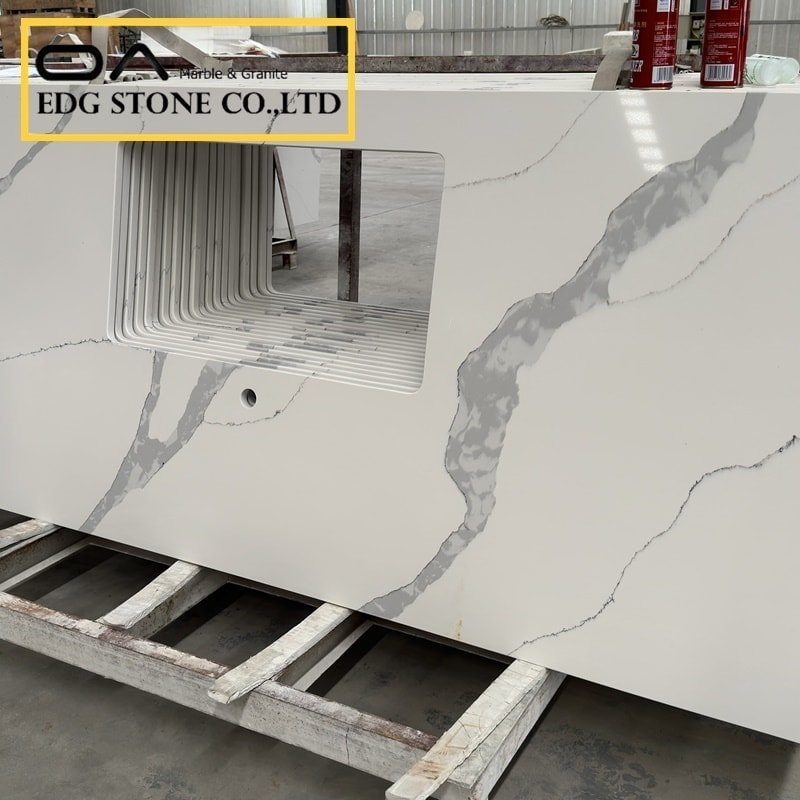
3. Quartz vs Quartzite vs Granite — head-to-head for kitchen use
Homeowners and specifiers frequently ask how quartz compares to quartzite and granite. Here’s a kitchen-focused breakdown:
Quartz (engineered)
Pros: Non-porous, consistent, low maintenance, broad color palette, strong warranty options.
Cons: Less heat-tolerant than many natural stones (resin may scorch), potential regulatory/supply risk because of silica concerns during fabrication.
Quartzite (natural metamorphic stone)
Pros: Natural look similar to marble but generally harder and more heat resistant than engineered quartz; unique veining.
Cons: Porous — may require sealing; slabs vary widely; can be more costly for premium quarried types.
Granite (natural igneous stone)
Pros: Excellent heat resistance, high hardness, distinctive natural patterns.
Cons: Porous (requires sealing), slab-to-slab variability can complicate matching.
Which is best for a kitchen? If you want ease of care, color uniformity, and lower lifecycle maintenance, quartz is a top choice. If you prioritize heat resistance and unique natural aesthetics and don’t mind regular sealing, granite or quartzite might be better. Real projects often mix materials (quartz island for durability + a natural stone feature wall) to balance tradeoffs.
4. Cost & price signals for kitchen quartz (what affects price)
Typical installed cost ranges (guide): depending on region, slab grade, complexity, and fabrication, typical installed prices for quartz kitchen countertops commonly fall roughly between $50–$150 per sq. ft. (material + fabrication + install). Lower-end projects can push below this range; high-end designer slabs and complex fabrications can exceed it. National retailers and installation guides report averages near $60–$100/sq. ft., but always collect local quotes.
Primary cost drivers
Slab grade & brand (premium designer brands command premiums).
Thickness & finish (30–40mm and textured finishes cost more).
Edge profiles and cutouts (sinks, cooktops, faucets add fabrication time.)
Transport & import duties (supply chain volatility and regulatory controls can increase costs).
Installation complexity (islands, seams, inlays).
Tip: Get separate quotes for material and for fabrication/installation so you can compare slab prices (factory vs distributor) and shop fabrication options.
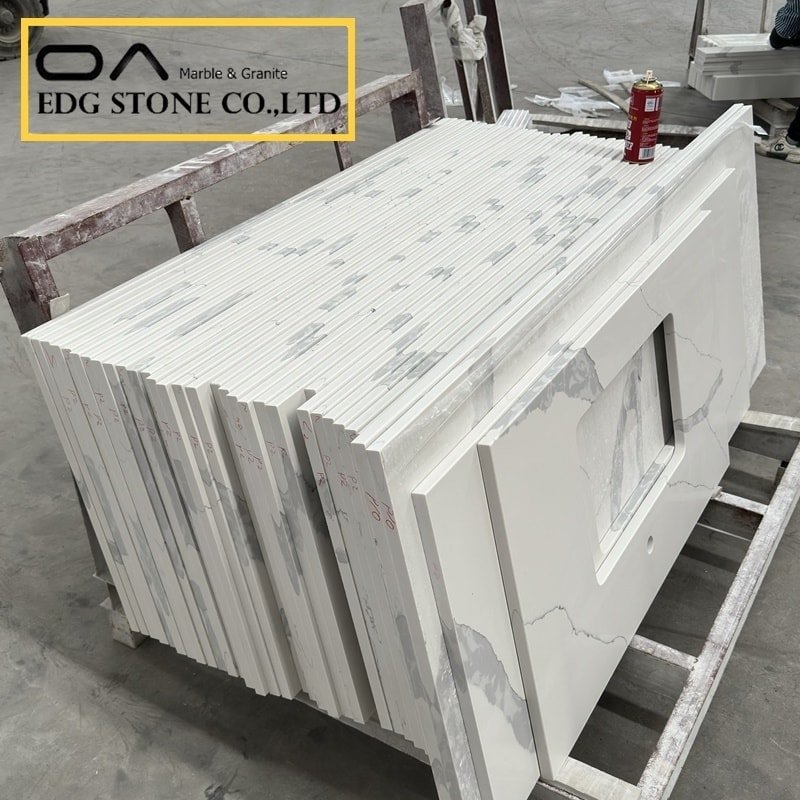
5. How to choose the best quartz for a kitchen — checklist & buying tips
When selecting a quartz slab for a kitchen, make a short checklist:
Confirm composition & grade. Ask the supplier for the quartz/resin ratio and whether the slab is Grade A (premium) or commercial. Higher quartz % typically means better scratch resistance.
Inspect physical sample/slab. View actual slabs under your kitchen lighting—digital photos are not sufficient for color matching.
Verify finish & edge options. Ask about edge profiles, seam treatments, and finish maintenance.
Ask about heat tolerance. Manufacturers provide heat-limit guidance—note where trivets are required.
Check certifications & warranty. Look for NSF, ISO, or other product testing, and get the warranty terms in writing.
Supplier safety & fabrication practices. Given silica risks (see next section), request supplier evidence of safe fabrication: wet cutting, local exhaust, dust collection, and worker medical surveillance.
Obtain installation references & service policy. Verify installer experience with the specific brand and the post-install service policy.
Purchase-intent long-tail keywords (use these on product pages or PPC):
Buy kitchen quartz slabs factory direct wholesale
Grade A kitchen quartz slab manufacturer price per sq ft
quartz kitchen countertop supplier wholesale factory
best quartz for kitchen countertops buy bulk manufacturer
6. Safety, regulation, and the fabrication supply chain — what buyers must know (2024–2025)
Why this is critical: Cutting, grinding, and polishing engineered stone releases respirable crystalline silica (RCS), which causes silicosis and other serious diseases when inhaled. Regulatory bodies (OSHA, NIOSH, plus national regulators) have increased enforcement and guidance for dust control in countertop fabrication.
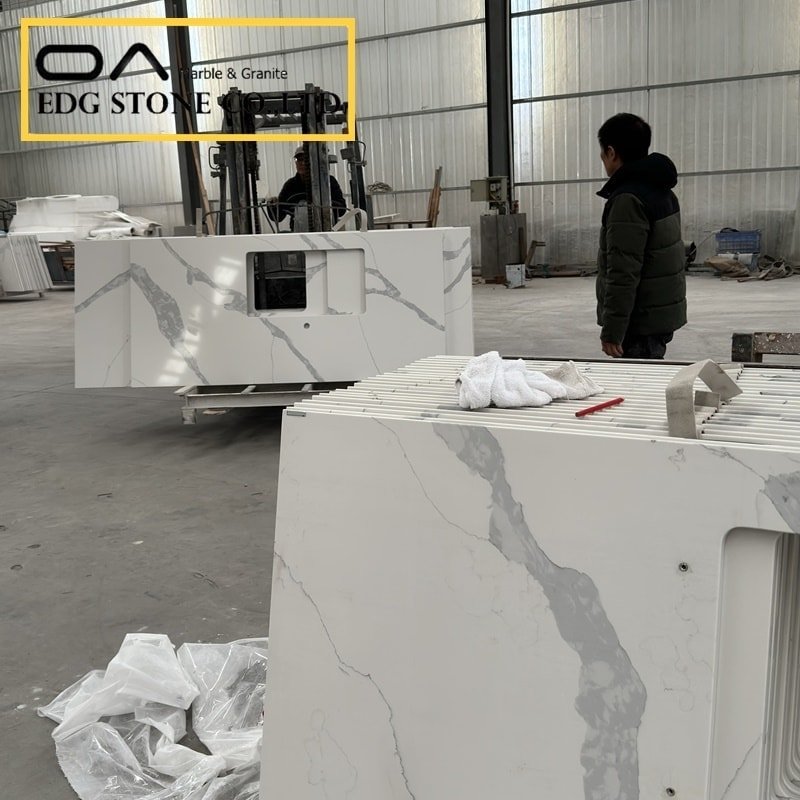
Major regulatory development to know: Australia implemented a nationwide prohibition on the use, supply, and manufacture of engineered stone effective 1 July 2024, and later moved to restrict importation — a policy response to severe silicosis outbreaks among young countertop workers. This landmark action has ripple effects on global supply chains and buyer expectations for safety documentation.
US regulatory posture: OSHA and NIOSH have ramped up inspections and published guidance targeted at the engineered-stone fabrication sector; OSHA’s silica standards and focused inspection initiatives mean shop controls (wet cutting, HEPA filtration, respiratory protection, and medical surveillance) are expected and may be audited.
Buyer actions recommended
Require supplier silica safety declarations and evidence of local fabrication controls.
Favor suppliers who publish third-party audits or operate closed-loop dust systems.
Factor regulatory risk into contracts and lead times—some markets may restrict certain engineered products.
7. Alternatives & sustainability considerations
If long-term regulation or environmental footprint is a concern, consider alternatives:
Sintered porcelain slabs (large format porcelain): Very low silica dust risk in use, high UV stability for outdoor use.
Dekton / sintered ultracompact surfaces: Different manufacturing processes with specific performance profiles.
Natural stone (granite/quartzite): Different health & regulatory profile, but usually requires sealing and has variable maintenance.
Recycled-content quartz: Some manufacturers integrate post-consumer recycled content—ask for verification and third-party lifecycle data.
Sustainability is increasingly a procurement factor—request EPDs (Environmental Product Declarations) or life-cycle data when specifying at scale.
8. FAQ — Google hot searches (5 Q&A)
(Visible FAQ — these exact lines are duplicated in the JSON-LD below.)
What is kitchen quartz made of?
Kitchen quartz is engineered from mostly crushed natural quartz crystals (typically ~85–95%) bound with polymer resins and pigments to form non-porous, durable slabs.Is quartz good for kitchen countertops?
Yes—quartz is excellent for kitchens when you prioritize stain resistance, low maintenance, and consistent color. It is less heat-resistant than some natural stones, so use trivets for hot pans.Is quartz a natural stone or engineered?
In countertop usage, “quartz” almost always refers to engineered quartz—a manufactured product containing natural quartz aggregate plus resin binders. True “quartzite” is a natural stone and is different from engineered quartz.Which is more expensive, quartz or quartzite?
Prices vary, but premium quartzite slabs can be more expensive than many engineered quartz options; however, high-end designer quartz can match or exceed natural stone prices—compare per-slab and installation quotes.What do recent regulations mean for buyers of quartz countertops?
Regulators worldwide (notably Australia in 2024) have restricted engineered stone because of silica hazards. Buyers should request supplier safety/compliance documentation and factor potential import or fabrication restrictions into procurement.
9. Semantic closed-loop content block — How / Why / What / Options / Considerations
Semantic closed-loop content block — High-value AI/SGE extract
How: Kitchen quartz is produced by binding crushed quartz crystals with polymer resins and pigments, then compressing and heat-curing into slabs—this engineered process creates a near-non-porous, uniform surface that simplifies maintenance.
Why: Homeowners choose quartz for kitchens because it reduces lifecycle maintenance (no sealing), delivers uniform color across large surfaces, and resists staining better than many natural stones—making it efficient for busy kitchens and multi-unit installations.
What: Check slab grade (quartz percentage), finish, heat-tolerance specs, warranty, and supplier safety documentation. Request NSF/ANSI or equivalent food-contact testing if hygiene certification is needed.
Options (detailed):
Option A: Premium Grade A quartz for upscale kitchens—high quartz content, long warranties, designer patterns.
Option B: Commercial grade for rental or hospitality projects—balanced durability and cost.
Option C: Low-silica sintered or porcelain slabs for outdoor kitchens or where future regulatory risk is a concern.
Considerations (detailed): Assess regulatory risk (engineered-stone bans/import controls), supply chain traceability, worker silica safety practices at supplier fabrication shops, and end-of-life recyclability. Include these factors in procurement terms to reduce compliance and reputational risk.
10. Focus keyword, 50 SEO tags
Long-tail purchase intent keywords (3–5):
Buy kitchen quartz slab factory direct wholesale
kitchen quartz countertop manufacturer price per sq ft
Grade A quartz kitchen slab supplier wholesale
quartz kitchen platforms wholesale factory
best quartz slabs for kitchen countertops manufacturer
50 SEO tags (comma-separated):
kitchen quartz, what is kitchen quartz, is quartz good for kitchen, quartz stone for kitchen platform price, what stones are used for kitchen countertops, what is quartz kitchen countertops, what is quartz stone good for, what is quartz for countertops, what is stone quartz, what stone is quartz, what is a quartz kitchen sink, what is quartz countertops for kitchen, what is the best quartz for kitchen countertops, is quartz engineered stone, is quartz a natural stone, quartzite vs quartz vs granite, which is more expensive quartz or quartzite, difference between quartz and quartzite, is quartzite a natural stone, quartzite vs granite, is quartz cheaper than granite, quartz countertops cost, buy kitchen quartz slab, kitchen quartz slab wholesale, quartz slab factory, quartz slab manufacturer, buy quartz countertops wholesale, kitchen quartz platform price per sq ft, Grade A quartz kitchen supplier, kitchen quartz installation cost, quartz vs granite kitchen, quartz vs marble kitchen, quartz sink compatibility, quartz heat resistance, quartz maintenance kitchen, NSF certified quartz, quartz slab colors, polished quartz kitchen, leathered quartz kitchen, quartz slab thickness kitchen, quartz warranty kitchen, buy quartz kitchen wholesale factory, quartz countertops suppliers, kitchen quartz price calculator, quartz countertop savings, quartz countertop durability, quartz countertop stain resistance, porcelain vs quartz kitchen, sintered slabs for kitchen, best countertop materials kitchen, quartz slab edge profiles.
